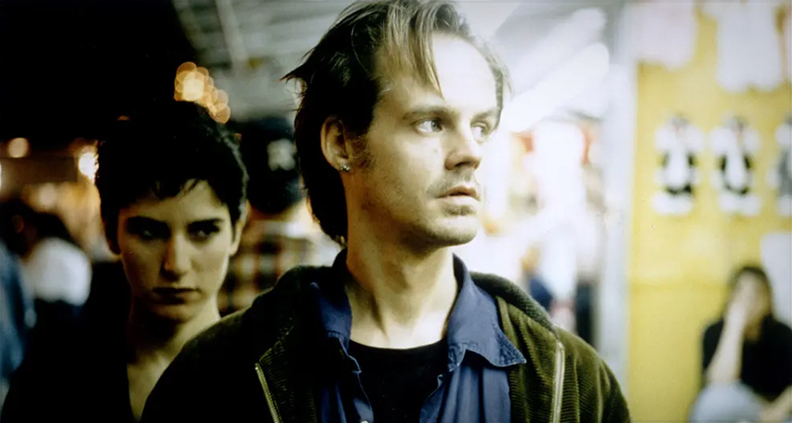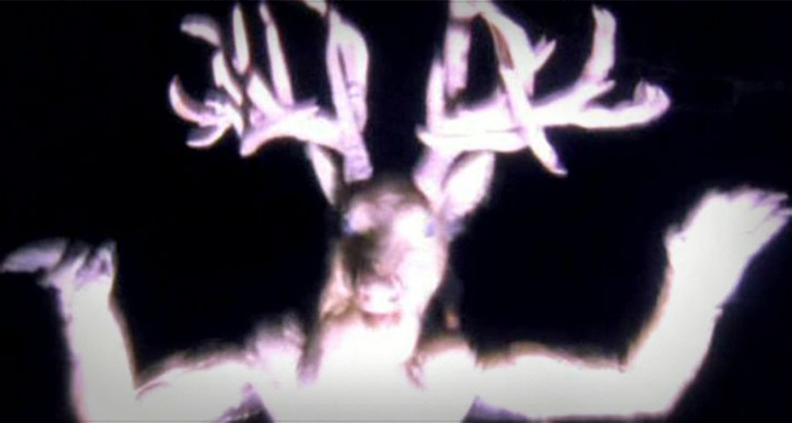In the first full scene of Larry Fessenden’s Habit—which earned the NY-based actor and filmmaker Film Independent’s Someone to Watch Award in 1997—a man clomps, semi-purposefully, around a New York City apartment, arranging boxes. That man, Sam (Fessenden himself), with his lanky frame holding up a large wool trench coat from which his head and flopping hair sprout like the top of a carrot, is so perfectly Gen-X and the wide-angle 16mm photography so perfectly ‘90s American indie that, watching it from a quarter of a century’s distance you might be forgiven for expecting a movie that has perhaps aged into self-parody. Or, rather, you would be if it weren’t for Habit’s actual opening: a brief, eerie procession of shots, including those a seemingly unmanned boat floating in midnight waters, all accompanied by Geoffrey Kidde’s ominous score. Before the screenplay’s first page is over, Fessenden has already established his assured, undeniably cinematic hand.
Turns out Sam—an erstwhile musician working as a night manager at a dive-y Manhattan Mexican joint—isn’t cleaning up his own apartment in that first scene. It’s that of his late father, who has recently died. But he has some rearranging to do at his place, too, since his longtime girlfriend, Liza (Heather Woodbury), has just moved out. So Sam’s not exactly at his best when he shows up, already well into a night of sorrow-drowning, at his friend’s Halloween party. Still, that doesn’t keep him from catching the eye of Anna (Meredith Snaider), a party-crasher who leaves with Sam only to mysteriously disappear when he runs back upstairs for his forgotten coat. Soon, though, Anna will show up again and again—quickly becoming a fixture in Sam’s life even as he is increasingly convinced that she’s, y’know, a vampire. Sam’s suspicions stem from Anna’s ability to seemingly appear or disappear without a trace, the fact that their intense and erotic sex life involves a lot of biting on her part and (most concerningly) his increasing illness and pallid demeanor. There’s an unsubtle metaphor at work here about the scary dangers of dating amidst the fear of AIDS. But Fessenden is clearly more interested in more specific, psychological allegories of indulging in compulsive behaviors and fixations as a means of not coping with emotional distress. It’s more likely that Sam’s physical deterioration is a result of his constant drunkenness than of Anna’s supposed state of undeath. But that doesn’t stop Fessenden from layering Habit with chilling, unabashedly genre-based touches like jump scares and near-subliminal shots of unexplained otherworldliness. It was, presumably, this blend of idiosyncratic independence and an unironic embrace of horror tradition that made Fessenden stand out enough to garner the Someone to Watch Award. I doubt anyone could have predicted, though, just what an epochal moment in American horror Habit would come to represent. Fessenden has continued to direct—we’ll get to his most recent effort shortly—but his legacy has been chiefly solidified by his work as a producer and an actor. In the former role, he’s helped shepherd to the screen early works from unique horror talents like Ti West (The House of the Devil), Ana Asensio (Most Beautiful Island) and Mickey Keating (Psychopaths). But it’s as an actor that he may have made the biggest impression. He shows up in roles of various sizes in horror flicks ranging from Brad Anderson’s Session 9 to Adam Wingard’s You’re Next, to Bridey Elliott’s Clara’s Ghost, to truly bizarre, under-the-radar works like Chad Crawford Kinkle’s Jug Face. The upshot? If you’re watching an independent horror film and Larry Fessenden shows up on screen, you know you picked something good. With strong showings from all of the directors listed above and more, American independent horror had a bit of a moment in the 2010s. It’s not difficult to imagine these filmmakers picking up Habit or Fessenden’s Wendigo (2001) at their local video store a decade before making their own films and being inspired by someone so geekily in love with the genre, yet so purely committed to making art that’s personal and new. Fessenden didn’t just kick off a career with Habit’s Someone to Watch award win (indeed, he’d already been directing for more than ten years); he kicked off a whole new wave of independent genre filmmaking. In many ways, 2019’s Depraved offers a sharp mirror-reflection of Habit (making it particularly well-suited to the format of this column). Nearly 25 years later, Fessenden returns to New York City, though now the boho apartments have been relocated from Manhattan to Gowanus. And he once again plucks his premise from the classic monster oeuvre, trading Habit’s seductive female Dracula for a PTSD-suffering combat vet version of Dr. Frankenstein, giving his monster a sensitive beefcake twist. Henry (David Call) is a brilliant doctor still reeling from his military experiences in the Middle East, who’s been given free rein by his childhood friend Polidori (Joshua Leonard), now a wealthy pharmaceutical exec, to pursue his life-restoring experiments, all in the name of testing experimental drugs. Using body parts (and a brain) procured by Polidori via methods about which Henry would rather not know, he’s created a new life whom he’s named Adam (Alex Breaux); for what it’s worth, Depraved both acknowledges the corniness of that name and, eventually, provides a powerful explanation for why Henry chose it. There’s no need to delve further into the plot in this space. As you might imagine, things don’t go smoothly and we can leave it at that. It’s more fun to instead dig into the more subtle similarities between Fessenden’s early and current work.
There remain hints of the occult that add more to the atmosphere than to the narrative. In Habit, Anna gives Sam a creepy two-headed figurine. In Depraved, one of Polidori’s unwilling donors was wearing a necklace with an arcane symbol on it—a present from the dead man’s girlfriend. Also intact is Fessenden’s penchant for sexual content as salacious as it is potentially upsetting. While nothing in Depraved approaches Habit’s Battery Park hand job scene, there’s a fascinating, almost humorous dichotomy found in the tenderly suggestive interactions between Adam and Henry’s girlfriend, Liz (Ana Kayne), and the more fantastical nightmare versions of these interactions plaguing Henry’s sleep. What shines through most from 1995 to 2019, though, is Fessenden’s ability to blend the topical with the personal. Where Habit embodied STI fears, Depraved explicitly invokes the opioid epidemic in its tale of human bodies treated as commodities by a greedy and heartless pharmaceutical industry. But beneath that is an emotional exploration of the necessity of nurture to human development and the anxiety of not knowing if you’re up to the task of parenting. It’s not surprising to discover these concerns in a man who served as forefather to an entire generation.
Other nominees: Joe Brewster followed up 1995’s The Keeper with 2003’s The Killing Zone before pivoting to documentaries, including 2013’s Emmy-nominated American Promise. Coincidentally, the year’s other nominee, Chris Smith, who directed American Job, traced a similar path, bolstering his reputation as a documentarian with 1999’s American Movie, followed by Home Movie and The Yes Men. In recent years, he’s been behind splashy Netflix doc fare like 2017’s Jim & Andy and last year’s Fyre.
Follow Film Independent…
Twitter YouTube Instagram Membership
(Header: Larry Fessenden’s 2019 film Depraved)

